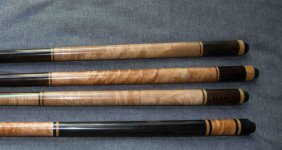Last year I was searching for a small piece of Holly and found a local hardwood dealer. No luck. While there I looked at the slabs of wood he had and a piece of maple caught my attention. It seemed to have some character to it and although not proficient in judging wood , I asked him what he wanted for it. He said 100 bucks.
This chunk of wood was 8’ high, 18” wide and two inches thick. I could not lift it. I thought how can I go wrong for a C-note.
So he put it in the pickup for me and off I went. Got it home, had my son-in-law help me get it cut down to manageable size and off I went to the shed to cut turning squares. Turned out to be quilted maple. Enough to make about 85 squares and a ton of slats for points. That’s about a $1.50 a square.
Over the next few months I made up some cues, showed them around ending up selling a few and using a couple myself. I liked them. They looked good, rolled straight and felt good in my hands.
I wondered why more cuemakers were no using quilted maple and that prompted my original AZ thread on quilted maple. Also went on the web and discovered that it is almost always found on big leaf maple (what the hell is that?) and that it grows out on the western side of the country, some place called Oregon.
Also found out through AZ search that I have no business using it unless I core it (stabilize it?) if I wanted to use it in cuemaking. Now they tell me.
Well, so far it’s doing fine. I checked out my own stuff and more importantly, the ones I sold and so far everything is as it should be. Time will tell. Still feel good about it.
It goes to prove that even a blind squirrel finds a nut once in a while

This chunk of wood was 8’ high, 18” wide and two inches thick. I could not lift it. I thought how can I go wrong for a C-note.
So he put it in the pickup for me and off I went. Got it home, had my son-in-law help me get it cut down to manageable size and off I went to the shed to cut turning squares. Turned out to be quilted maple. Enough to make about 85 squares and a ton of slats for points. That’s about a $1.50 a square.
Over the next few months I made up some cues, showed them around ending up selling a few and using a couple myself. I liked them. They looked good, rolled straight and felt good in my hands.
I wondered why more cuemakers were no using quilted maple and that prompted my original AZ thread on quilted maple. Also went on the web and discovered that it is almost always found on big leaf maple (what the hell is that?) and that it grows out on the western side of the country, some place called Oregon.
Also found out through AZ search that I have no business using it unless I core it (stabilize it?) if I wanted to use it in cuemaking. Now they tell me.
Well, so far it’s doing fine. I checked out my own stuff and more importantly, the ones I sold and so far everything is as it should be. Time will tell. Still feel good about it.
It goes to prove that even a blind squirrel finds a nut once in a while

Last edited: